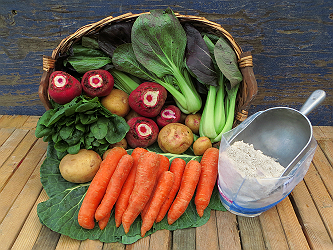
Standard
Red Baby Bok Choy 1 lb
Apples 2 lbs
Hard Red Wheat Flour 2 lbs
Carrots 3 lbs
Leeks 2
Green Kale 1 bu
Green Cabbage 1 hd
Red Beets 2 lbs

Small
Red Baby Bok Choy 1 lb
Collards 1 bu
Spinach 1 bu
Hard Red Wheat Flour 2 lbs
Carrots 2 lbs
Chioggia Beets 2 lbs
Potatoes 3 lbs
Red Baby Bok Choy
Bok choy’s name is derived from the Chinese name for “soup spoon” because of the shape of its leaves. The red pigmentation in the leaves of the red bok choy is due to the presence of anthocyanins. Anthocyanins are a type of flavonoid pigment that are responsible for the red, purple and blue colors in plants. The concentration of anthocyanin polyphenols in red bok choy’s leaves provide health benefits as dietary antioxidants, as an anti-inflammatory, and they have potentially protective, preventative, and therapeutic roles in a number of human diseases, including cancer.
Red bok choy can be used in any recipe calling for bok choy. It can be added to soups, sautéed, steamed and eaten raw in a salad. As an all-purpose vegetable, it can add a warm, brothy and umami-like note to savory recipes. Complementary pairings include garlic, ginger, mushrooms, soy sauce, tofu, pork, white fish, noodles, grains, chicken broth, light bodied vinegars, citrus, ginger and chilies.
Red Bok Choy Sauté
1 Tbsp. organic veggie oil
1 garlic cloves, peeled and minced
1 1/4-inch piece ginger root, peeled and minced
Pinch red-pepper flakes, or to taste
1 bunch red baby bok choy, cleaned, with the ends trimmed
1 tsp. soy sauce
1 tsp. chicken stock or water
Toasted sesame oil for drizzling
In sauté pan with lid, heat oil over medium-high heat until it starts to shimmer. Add garlic, ginger and red-pepper flakes and cook, stirring constantly, until fragrant, about 45 seconds.
Add bok choy and stir carefully to cover with oil, then cook for approximately 2 minutes. Add soy sauce, stock or water, then cover pan and cook for approximately 2 minutes more, until steam begins to escape.
Uncover and continue to cook until liquid is close to evaporated and stalks are soft to the touch, approximately 3 minutes more.
Remove to a warmed platter and drizzle with sesame oil.
Hard Red Wheat Flour
A basic rule of thumb is that hard wheat (red or white) creates structure in a baked item, so it is good for breads and pretzels. The higher gluten content makes it possible to hold a shape and even bake without a pan, like those round European artisan loaves.
Soft wheat has less gluten and creates a crumbly or fluffy texture. It’s excellent for pastries, that either need a baking pan to hold their shape, like a cake, or they flatten out, like cookies or pancakes. They can also use a reinforcement to give the dough structure, like eggs.
Nash’s hard red wheat is our go-to flour for bread. It is high in protein and high in gluten, so your bread rises well. It gives a hearty, nutty flavor and produces a crisp crust and a crumb with desirable irregular holes. As its name suggests, it gives your bread a slight reddish color. It is great for sourdough or yeasted breads, but also lends itself well to biscuits, pancakes, muffins, cookies, pizza and pie crusts and for thickening stews and gravies.
Some bread making tips
- Whole wheat flour takes longer than refined white flour to absorb moisture. So give your dough time alone after mixing (but before kneading). Cover the dough and let it rest for 10 minutes, then do it again part way through kneading. It will be much less work for you, and your bread will have more air bubbles.
- Knead with water, not flour. Lightly dampen your work surface to prevent your dough from drying out.
- Whole wheat bread especially benefits from longer rises. You use less yeast to make this happen so the bread rises more slowly. Your bread will be much moister this way.
- Here’s a good website to start making bread!
